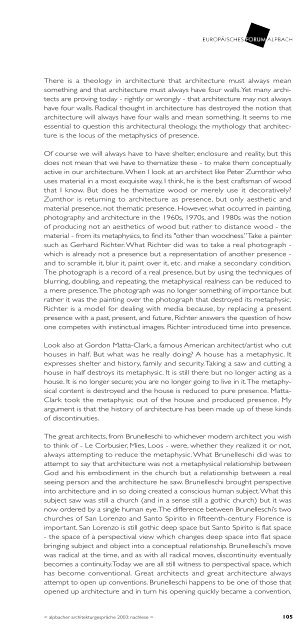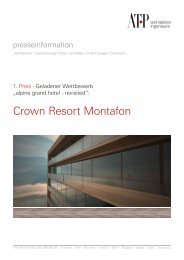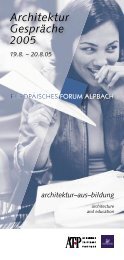alpbacher architekturgespräche 2003 - ATP
alpbacher architekturgespräche 2003 - ATP
alpbacher architekturgespräche 2003 - ATP
Erfolgreiche ePaper selbst erstellen
Machen Sie aus Ihren PDF Publikationen ein blätterbares Flipbook mit unserer einzigartigen Google optimierten e-Paper Software.
There is a theology in architecture that architecture must always mean<br />
something and that architecture must always have four walls.Yet many architects<br />
are proving today - rightly or wrongly - that architecture may not always<br />
have four walls. Radical thought in architecture has destroyed the notion that<br />
architecture will always have four walls and mean something. It seems to me<br />
essential to question this architectural theology, the mythology that architecture<br />
is the locus of the metaphysics of presence.<br />
Of course we will always have to have shelter, enclosure and reality, but this<br />
does not mean that we have to thematize these - to make them conceptually<br />
active in our architecture.When I look at an architect like Peter Zumthor who<br />
uses material in a most exquisite way, I think, he is the best craftsman of wood<br />
that I know. But does he thematize wood or merely use it decoratively?<br />
Zumthor is returning to architecture as presence, but only aesthetic and<br />
material presence, not thematic presence. However, what occurred in painting,<br />
photography and architecture in the 1960s, 1970s, and 1980s was the notion<br />
of producing not an aesthetics of wood but rather to distance wood - the<br />
material - from its metaphysics, to find its "other than woodness.”Take a painter<br />
such as Gerhard Richter.What Richter did was to take a real photograph -<br />
which is already not a presence but a representation of another presence -<br />
and to scramble it, blur it, paint over it, etc. and make a secondary condition.<br />
The photograph is a record of a real presence, but by using the techniques of<br />
blurring, doubling, and repeating, the metaphysical realness can be reduced to<br />
a mere presence.The photograph was no longer something of importance but<br />
rather it was the painting over the photograph that destroyed its metaphysic.<br />
Richter is a model for dealing with media because, by replacing a present<br />
presence with a past, present, and future, Richter answers the question of how<br />
one competes with instinctual images. Richter introduced time into presence.<br />
Look also at Gordon Matta-Clark, a famous American architect/artist who cut<br />
houses in half. But what was he really doing? A house has a metaphysic. It<br />
expresses shelter and history, family and security.Taking a saw and cutting a<br />
house in half destroys its metaphysic. It is still there but no longer acting as a<br />
house. It is no longer secure; you are no longer going to live in it.The metaphysical<br />
content is destroyed and the house is reduced to pure presence. Matta-<br />
Clark took the metaphysic out of the house and produced presence. My<br />
argument is that the history of architecture has been made up of these kinds<br />
of discontinuities.<br />
The great architects, from Brunelleschi to whichever modern architect you wish<br />
to think of - Le Corbusier, Mies, Loos - were, whether they realized it or not,<br />
always attempting to reduce the metaphysic.What Brunelleschi did was to<br />
attempt to say that architecture was not a metaphysical relationship between<br />
God and his embodiment in the church but a relationship between a real<br />
seeing person and the architecture he saw. Brunelleschi brought perspective<br />
into architecture and in so doing created a conscious human subject.What this<br />
subject saw was still a church (and in a sense still a gothic church) but it was<br />
now ordered by a single human eye.The difference between Brunelleschi’s two<br />
churches of San Lorenzo and Santo Spirito in fifteenth-century Florence is<br />
important. San Lorenzo is still gothic deep space but Santo Spirito is flat space<br />
- the space of a perspectival view which changes deep space into flat space<br />
bringing subject and object into a conceptual relationship. Brunelleschi’s move<br />
was radical at the time, and as with all radical moves, discontinuity eventually<br />
becomes a continuity.Today we are all still witness to perspectival space, which<br />
has become conventional. Great architects and great architecture always<br />
attempt to open up conventions. Brunelleschi happens to be one of those that<br />
opened up architecture and in turn his opening quickly became a convention.<br />
< <strong>alpbacher</strong> <strong>architekturgespräche</strong> <strong>2003</strong>: nachlese > 105






